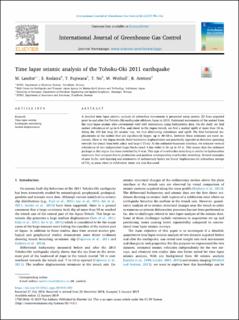| dc.contributor.author | Landrø, Martin | |
| dc.contributor.author | Kodaira, Shuichi | |
| dc.contributor.author | Fujiwara, toshiya | |
| dc.contributor.author | No, Tetsuo | |
| dc.contributor.author | Weibull, Wiktor Waldemar | |
| dc.contributor.author | Arntsen, Børge | |
| dc.date.accessioned | 2023-01-18T11:17:12Z | |
| dc.date.available | 2023-01-18T11:17:12Z | |
| dc.date.created | 2019-01-14T09:25:06Z | |
| dc.date.issued | 2019 | |
| dc.identifier.citation | Landrø, M., Kodaira, S., Fujiwara, T., No, T., Weibull, W., & Arntsen, B. (2019). Time lapse seismic analysis of the Tohoku-Oki 2011 earthquake. International Journal of Greenhouse Gas Control, 82, 98-116. | en_US |
| dc.identifier.issn | 1750-5836 | |
| dc.identifier.uri | https://hdl.handle.net/11250/3044257 | |
| dc.description.abstract | A detailed time lapse seismic analysis of subsurface movements is presented using seismic 2D lines acquired prior to and after the Tohoku-Oki earthquake offshore Japan in 2011. Estimated movements of the seabed from the time lapse seismic data corresponds well with estimations using bathymetric data. On the shelf, we find seabed subsidence of up to 8–9 m, and closer to the Japan trench, we find a seabed uplift of more than 10 m. Along the 100 km long 2D seismic line, we find alternating subsidence and uplift. We find horizontal displacements at the seabed that are significantly larger, up to 40–50 m, however these estimates are more uncertain. Close to the Japan trench, these horizontal displacements are practically opposite in direction (pointing towards the trench from both sides) and large (˜15 m). At the sediment-basement interface, we estimate vertical subsidence of two independent large blocks (each 4 km wide) to be up to 14 m. This means that the sediment package in this region has been stretched by 5–6 m. This type of overburden stretching is similar to hydrocarbon reservoirs that compact due to production and produce corresponding overburden stretching. Several examples of new faults, new layering and orientation of sedimentary layers are found. Implications for subsurface storage of CO2 in areas close to subduction zones are also discussed. | en_US |
| dc.language.iso | eng | en_US |
| dc.publisher | Elsevier | en_US |
| dc.rights | Navngivelse 4.0 Internasjonal | * |
| dc.rights.uri | http://creativecommons.org/licenses/by/4.0/deed.no | * |
| dc.title | Time lapse seismic analysis of the Tohoku-Oki 2011 earthquake | en_US |
| dc.type | Peer reviewed | en_US |
| dc.type | Journal article | en_US |
| dc.description.version | publishedVersion | en_US |
| dc.rights.holder | The authors | en_US |
| dc.subject.nsi | VDP::Matematikk og Naturvitenskap: 400 | en_US |
| dc.source.pagenumber | 98-116 | en_US |
| dc.source.volume | 82 | en_US |
| dc.source.journal | International Journal of Greenhouse Gas Control | en_US |
| dc.identifier.doi | 10.1016/j.ijggc.2019.01.002 | |
| dc.identifier.cristin | 1655827 | |
| dc.relation.project | Norges forskningsråd: 228400 | en_US |
| dc.relation.project | Norges forskningsråd: 254748 | en_US |
| cristin.unitcode | 217,8,11,0 | |
| cristin.unitname | Institutt for energiressurser | |
| cristin.ispublished | true | |
| cristin.fulltext | preprint | |
| cristin.qualitycode | 2 | |

